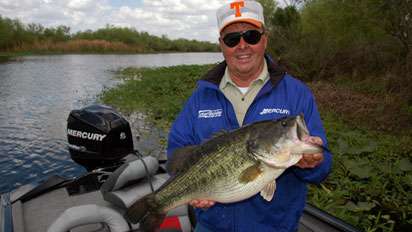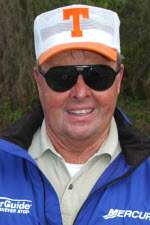
After so many years chasing fish, you have to know I’m a have-tackle-will-travel bass angler. I have really been blessed to fish many locations for so many kinds of fish, but still my favorite fishing holes remains those similar to the ones where I first wet a line — small creeks and rivers.
I grew up on such small, running waters in Tennessee, and it’s what got me hooked on this wonderful sport. So there is a definite tie between me and small waters that move. Rivers are like that for many of us, really. They are magnetic and special. We are drawn to them. Maybe it’s because by their nature they represent an escape, freedom and wilderness in our minds. Yep, they signify all this and more, in addition to great fishing!
Speaking of the latter, an added allure of small rivers and creeks for bass anglers in my region is that they also hold largemouth, smallies and spotted bass.
You can fish rivers and creeks year ’round with success, but they can be especially good in the summer heat, when the fishing gets tough on the big reservoirs. (In the summer months, the oxygen content remains higher in running water, translating to more active fish. It’s also a good place to escape from the armada of recreational boaters.)
I most often find the largemouth in the slow or slack water, while the Kentucky bass and smallmouths are going to most often haunt the swifter currents. And remember, once you know how bass behave in a particular environment, you are on your way to understanding how to catch them.
I bet wherever you live your GPS or a map can show you such nearby special strips of blue. So here, let me give you some tips on going out and enjoying them.
- Eddies are key features in running water. Basically, eddies are caused when an obstruction or break (like a bridge piling, log, point, gravel bar, boulder or whatever) causes a water current to change speed and direction. Often in such areas, there is also slack water, or pools with this forced change in flow. Fish love it as they do with most transition areas in water.
- Eddies can be horizontal with water flowing out and around an object. They can also be vertical with water pushing upward from some change along the bottom. Regardless of the flow, eddies are top-notch feeding areas, attracting baitfish and predators as well.
- My experience is that when the water temperature is above 50 degrees, you should fish above an eddy break for best results. On the other hand, when it is below that 50-degree mark, the slack water in the back of an eddy will be best.
- When bass fishing rivers and creeks, I strongly suggest you do not waste time fishing straight stretches of river. Seek out the areas with eddies and/or current changes to find more bass.
- Fishing current can cause control problems, of course. Water flow can and will affect boat control, lure presentation and feel for strikes. A lot of this can be cured by simply fishing upstream or across the current. Casting upstream and retrieving with current also gives fish more time to react to your presentation as most often bass will be facing into the current.
An angler can learn a lot about fishing small rivers and creeks. And I really think a fisherman well schooled in the challenges these areas present can easily go and catch fish on the big reservoirs. But I am not so sure that can be done by reservoir fishermen when they first venture to running water.
Conditions often change both rapidly and drastically in a river or creek. Areas that are easy to fish today could be inaccessible tomorrow after a torrential downpour. Likewise, what’s calm one day can be blowing and going the next. In short, running water anglers face constant changes.
These areas are special. And because these are smaller waters, such fisheries deserve added protection/conservation practices. Consider practicing catch-and-release so others can enjoy it as well. And remember, you don’t go fishing on small rivers and creeks with expectations of catching lunkers. You go with the idea of having a fun time with light tackle and battles with wild river fish. Try it. I feel confident you will enjoy the experience.
For more words of wit and wisdom from one of our sport’s greatest legends, check out www.billdanceoutdoors.com.

